66 11.1 What is an Earthquake?
An earthquake is the shaking caused by the rupture (breaking) and subsequent displacement of rocks (one body of rock moving with respect to another) beneath Earth’s surface.
A body of rock that is under stress becomes deformed. When the rock can no longer withstand the deformation, it breaks and the two sides slide past each other. Most earthquakes take place near plate boundaries—but not necessarily right on a boundary—and not necessarily even on a pre-existing fault.
The engineering principle of elastic deformation, which can be used to understand earthquakes, is illustrated in Figure 11.1.1. The stress applied to a rock—typically because of ongoing plate movement—results in strain or deformation of the rock (Figure 11.1.1b). Because most rock is strong (unlike loose sand, for example), it can withstand a significant amount of deformation without breaking. But every rock has a deformation limit and will rupture (break) once that limit is reached. At that point, in the case of rocks within the crust, the rock breaks and there is displacement along the rupture surface (Figure 11.1.1c). The magnitude of the earthquake depends on the extent of the area that breaks (the area of the rupture surface) and the average amount of displacement (sliding).
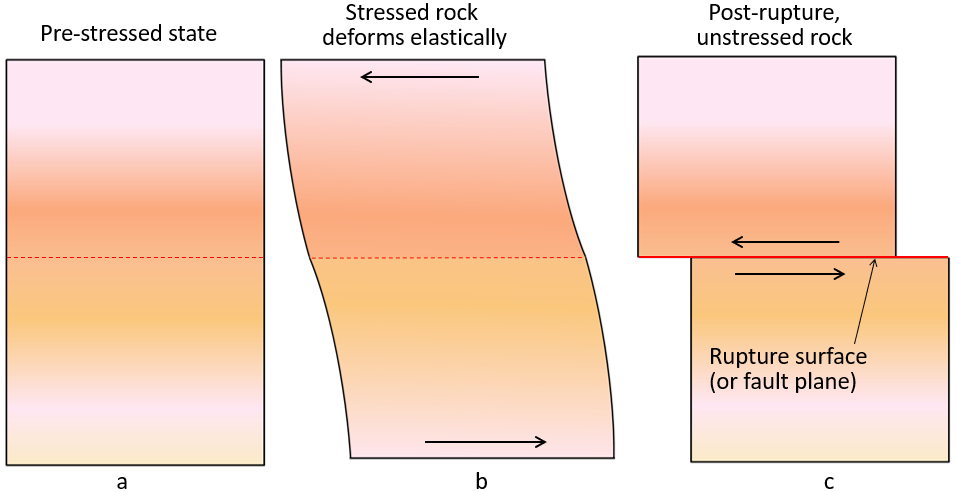
The concept of a rupture surface, which is critical to understanding earthquakes, is illustrated in Figure 11.1.2. An earthquake does not happen at a point, it happens over an area within a plane, although not necessarily a flat plane. Within the area of the rupture surface, the amount of displacement is variable (Figure 11.1.2), and, by definition, it decreases to zero at the edges of the rupture surface because the rock beyond that point isn’t displaced at all. The extent of a rupture surface and the amount of displacement will depend on a number of factors, including the type and strength of the rock, and the degree to which it was stressed beforehand.
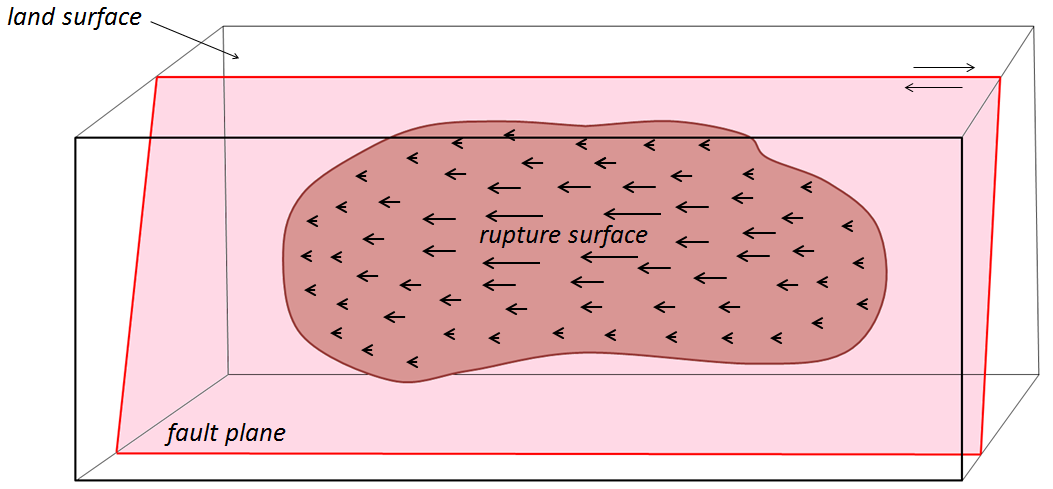
Earthquake rupture doesn’t happen all at once; it starts at a single point and spreads rapidly from there. Depending on the extent of the rupture surface, the propagation of failures out from the point of initiation is typically completed within seconds to several tens of seconds (Figure 11.1.3). The initiation point isn’t necessarily in the centre of the rupture surface; it may be close to one end, near the top, or near the bottom.
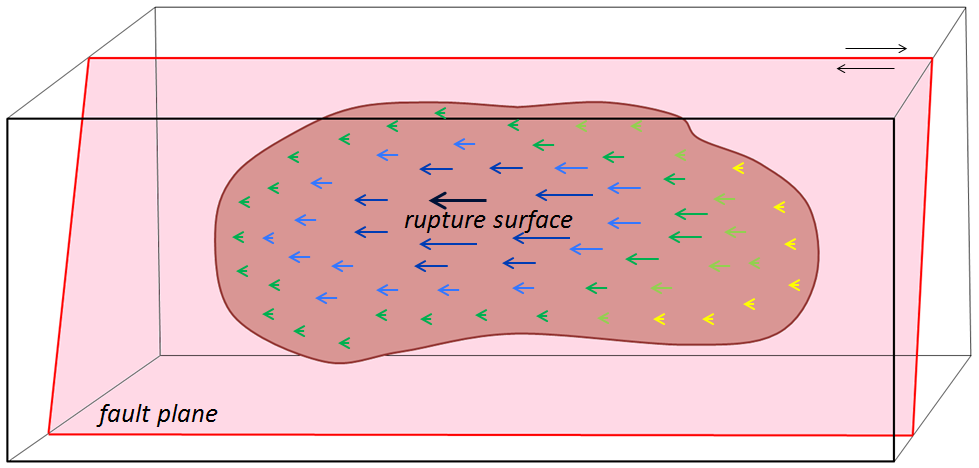
Figure 11.1.4 shows the distribution of immediate aftershocks associated with the 1989 Loma Prieta earthquake. Panel (b) is a section along the San Andreas Fault; this view is equivalent to what is shown in Figures 11.1.2 and 11.1.3. The area of red dots is the rupture surface; each red dot is a specific aftershock that was recorded on a seismometer. The hexagon labelled “main earthquake” represents the first or main shock. When that happened, the rock at that location broke and was displaced. That released the stress on that particular part of the fault, but it resulted in an increase of the stress on other nearby parts of the fault, and contributed to a cascade of smaller ruptures (aftershocks), in this case, over an area about 60 kilometres long and 15 kilometres wide.

So, what exactly is an aftershock then? An aftershock is an earthquake just like any other, but it is one that can be shown to have been triggered by stress transfer from a preceding earthquake. Within a few tens of seconds of the main Loma Prieta earthquake, there were hundreds of smaller aftershocks; their distribution defines the area of the rupture surface.
Aftershocks can be of any magnitude. Most are smaller than the earthquake that triggered them, but they can be bigger. The aftershocks shown in Figure 11.1.4 all happened within seconds or minutes of the main shock, but aftershocks can be delayed for hours, days, weeks, or even years. As already noted, aftershocks are related to stress transfer. For example, the main shock of the Loma Prieta earthquake triggered aftershocks in the immediate area, which triggered more in the surrounding area, eventually extending for 30 kilometres along the fault in each direction and for 15 kilometres toward the surface. But the earthquake as a whole also changed the stress on adjacent parts of the San Andreas Fault. This effect, which has been modelled for numerous earthquakes and active faults around the world, is depicted in Figure 11.1.5. Stress was reduced in the area of the rupture (blue), but was increased at either end of the rupture surface (red and yellow).
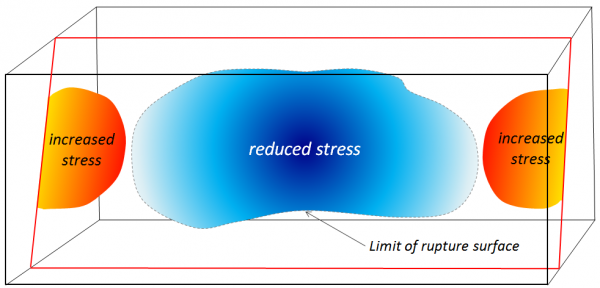
Stress transfer isn’t necessarily restricted to the fault along which an earthquake happened. It will affect the rocks in general around the site of the earthquake and may lead to increased stress on other faults in the region. The effects of stress transfer don’t necessarily show up right away. Segments of faults are typically in some state of stress, and the transfer of stress from another area is only rarely enough to push a fault segment beyond its limits to the point of rupture. The stress that is added by stress transfer accumulates along with the ongoing buildup of stress from plate motion and eventually leads to another earthquake.
Episodic Tremor and Slip
Episodic tremor and slip (ETS) is periodic slow sliding along part of a subduction boundary. It does not produce recognizable earthquakes, but does produce seismic tremor (rapid seismic vibrations on a seismometer). It was first discovered on the Vancouver Island part of the Cascadia subduction zone by Geological Survey of Canada geologists Herb Dragert and Garry Rogers.[1]
The boundary between the subducting Juan de Fuca Plate and the North America Plate can be divided into three segments (Figure 11.1.6). The cold upper part of the Juan de Fuca Plate boundary is locked. The plates are stuck and don’t move, except with very large earthquakes that happen approximately every 500 years (the last one was approximately M9 on January 26, 1700). The warm lower part of the boundary is sliding continuously because the warm rock is weaker. The central part of the boundary isn’t cold enough to be stuck, but isn’t warm enough to slide continuously. Instead it slips episodically, approximately every 14 months for about 2 weeks, moving a few centimetres each time.
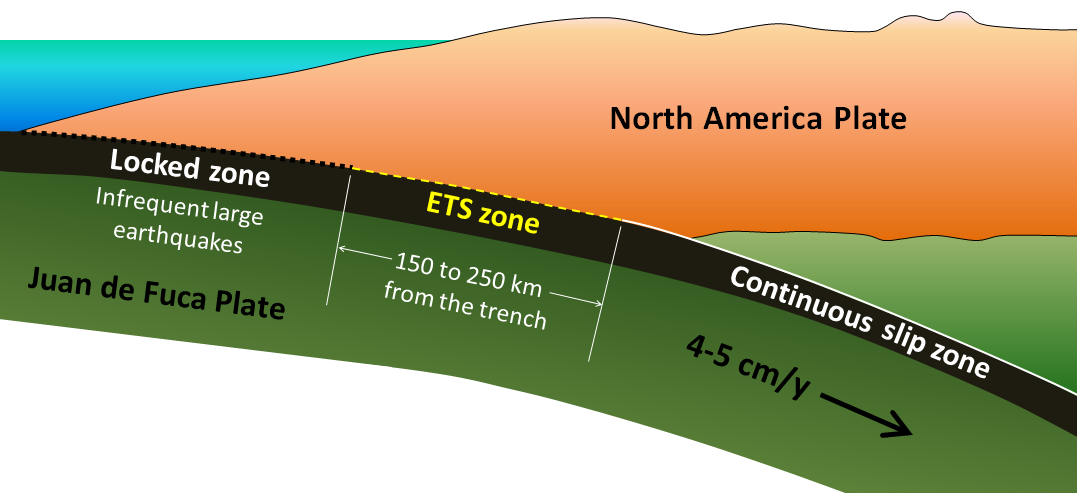
You might be inclined to think that it’s a good thing that there is periodic slip on this part of the plate because it releases some of the tension and reduces the risk of a large earthquake. In fact, the opposite is likely the case. The movement along the ETS part of the plate boundary acts like a medium-sized earthquake and leads to stress transfer to the adjacent locked part of the plate. Approximately every 14 months, during the two-week ETS period, there is a transfer of stress to the shallow locked part of the Cascadia subduction zone, and therefore an increased chance of a large earthquake.
Since 2003, ETS processes have also been observed on subduction zones in Mexico, New Zealand and Japan.
Media Attributions
- Figure 11.1.1, 11.1.2, 11.1.3, 11.1.6: © Steven Earle. CC BY.
- Figure 11.1.4: © Open University. CC BY-SA.
- Figure 11.1.5: © Steven Earle. CC BY. Based on data from 2010 Laguna Salada earthquake by Stein and Toda.
- Rogers, G. and Dragert, H., 2003, Episodic tremor and slip on the Cascadia subduction zone: the chatter of silent slip, Science, V. 300, p. 1942-1943. ↵
Mass wasting happens because tectonic processes have created uplift. Erosion, driven by gravity, is the inevitable response to that uplift, and various types of erosion, including mass wasting, have created slopes in the uplifted regions. Slope stability is ultimately determined by two factors: the angle of the slope and the strength of the materials on it.
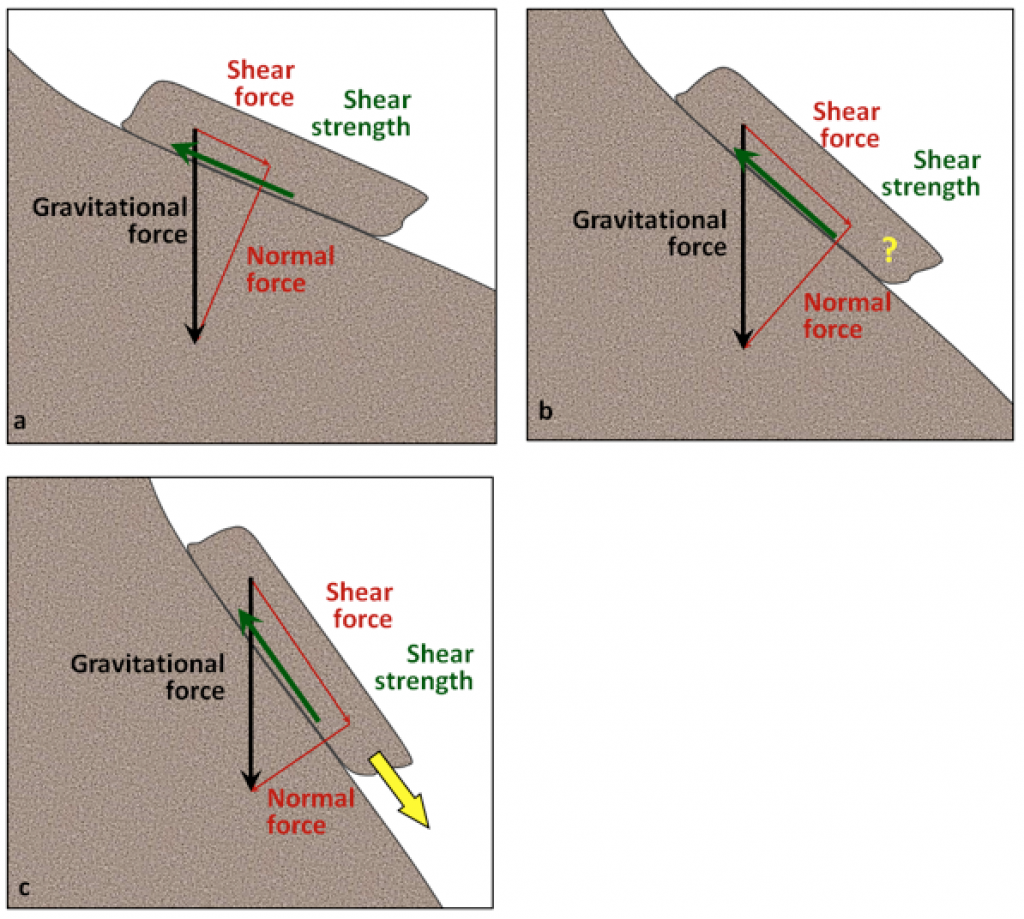
Figure 15.2 shows a block of rock situated on a rock slope. The block is being pulled toward Earth’s centre (vertically down) by gravity. We can split the vertical gravitational force into two components relative to the slope: one pushing the block down the slope (the shear force), and the other pushing into the slope (the normal force). The shear force, which wants to push the block down the slope, has to overcome the strength of the connection between the block and the slope, which may be quite weak if the block has split away from the main body of rock, or may be very strong if the block is still a part of the rock. This is the shear strength, and in Figure 15.1.1a, it is greater than the shear force, so the block should not move. In Figure 15.1.1b the slope is steeper and the shear force is approximately equal to the shear strength. The block may or may not move under these circumstances. In Figure 15.1.1c, the slope is steeper still, so the shear force is considerably greater than the shear strength, and the block will very likely move.
As already noted, slopes are created by uplift followed by erosion. In areas with relatively recent uplift (such as most of British Columbia and the western part of Alberta), slopes tend to be quite steep. This is especially true where glaciation has taken place because glaciers in mountainous terrain create steep-sided valleys. In areas without recent uplift (such as central Canada), slopes are less steep because hundreds of millions of years of erosion (including mass wasting) has made them that way. However, as we’ll see, some mass wasting can happen even on relatively gentle slopes.
The strength of the materials on slopes can vary widely. Solid rocks tend to be strong, but there is a very wide range of rock strength. If we consider just the strength of the rocks, and ignore issues like fracturing and layering, then most crystalline rocks—like granite, basalt, or gneiss—are very strong, while some metamorphic rocks—like schist—are moderately strong. Sedimentary rocks have variable strength. Dolostone and some limestone are strong, most sandstone and conglomerate are moderately strong, and some sandstone and all mudstones are quite weak.
Fractures, metamorphic foliation, or bedding can significantly reduce the strength of a body of rock, and in the context of mass wasting, this is most critical if the planes of weakness are parallel to the slope and least critical if they are perpendicular to the slope. This is illustrated in Figure 15.1.2. At locations A and B the bedding is nearly perpendicular to the slope and the situation is relatively stable. At location D the bedding is nearly parallel to the slope and the situation is quite unstable. At location C the bedding is nearly horizontal and the stability is intermediate between the other two extremes.
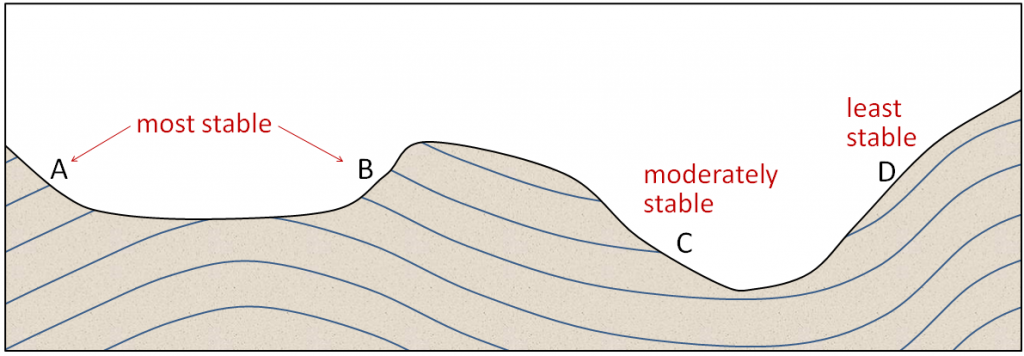
Internal variations in the composition and structure of rocks can significantly affect their strength. Schist, for example, may have layers that are rich in sheet silicates (mica or chlorite) and these will tend to be weaker than other layers. Some minerals tend to be more susceptible to weathering than others, and the weathered products are commonly quite weak (e.g., the clay formed from feldspar). The side of Johnson Peak that failed in 1965 (Hope Slide) is made up of chlorite schist (metamorphosed sea-floor basalt) that has feldspar-bearing sills within it (they are evident within the inset area of Figure 15.0.1). The foliation and the sills are parallel to the steep slope. The schist is relatively weak to begin with, and the feldspar in the sills, which has been altered to clay, makes it even weaker.
Unconsolidated sediments are generally weaker than sedimentary rocks because they are not cemented and, in most cases, have not been significantly compressed by overlying materials. This binding property of sediment is sometimes referred to as cohesion. Sand and silt tend to be particularly weak, clay is generally a little stronger, and sand mixed with clay can be stronger still. The deposits that make up the cliffs at Point Grey in Vancouver include sand, silt, and clay overlain by sand. As shown in Figure 15.1.3 (left) the finer deposits are relatively strong (they maintain a steep slope), while the overlying sand is relatively weak, and has a shallower slope that has recently failed. Glacial till—typically a mixture of clay, silt, sand, gravel, and larger clasts—forms and is compressed beneath tens to thousands of metres of glacial ice so it can be as strong as some sedimentary rock (Figure 15.1.3, right).

Apart from the type of material on a slope, the amount of water that the material contains is the most important factor controlling its strength. This is especially true for unconsolidated materials, like those shown in Figure 15.1.3, but it also applies to bodies of rock. Granular sediments, like the sand at Point Grey, have lots of spaces between the grains. Those spaces may be completely dry (filled only with air); or moist (often meaning that some spaces are water filled, some grains have a film of water around them, and small amounts of water are present where grains are touching each other); or completely saturated (Figure 15.1.4). Unconsolidated sediments tend to be strongest when they are moist because the small amounts of water at the grain boundaries hold the grains together with surface tension. Dry sediments are held together only by the friction between grains, and if they are well sorted or well rounded, or both, that cohesion is weak. Saturated sediments tend to be the weakest of all because the large amount of water actually pushes the grains apart, reducing the mount friction between grains. This is especially true if the water is under pressure.
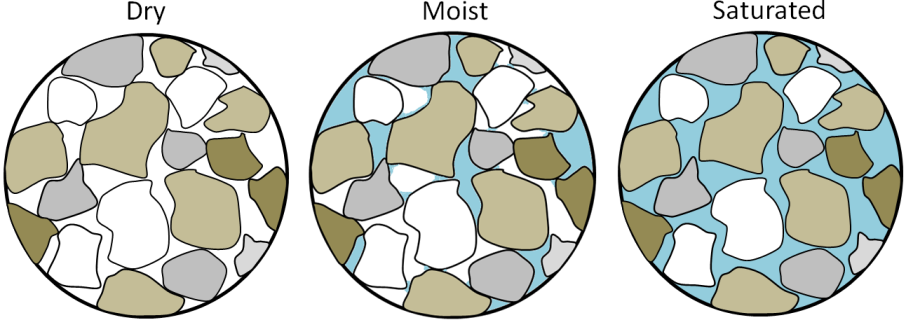
Exercise 15.1 Sand and water
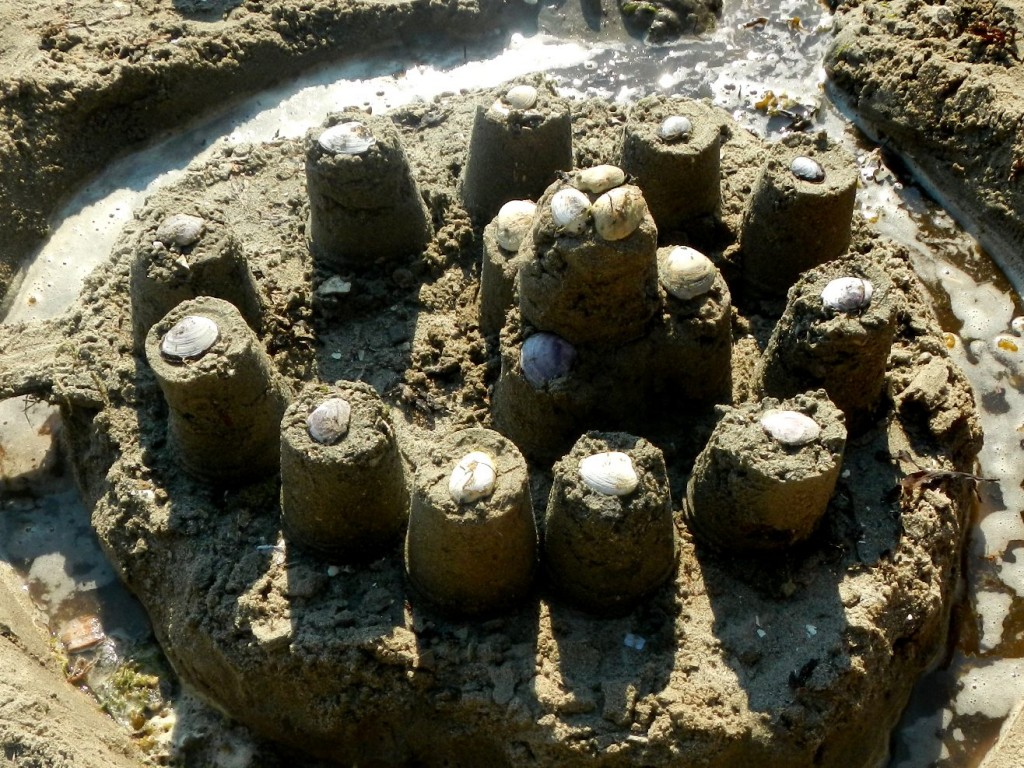
If you’ve ever been to the beach, you’ll already know that sand behaves differently when it’s dry than it does when it’s wet, but it’s worth taking a systematic look at the differences in its behaviour. Find about half a cup of clean, dry sand (or get some wet sand and dry it out), and then pour it from your hand onto a piece of paper. You should be able to make a cone-shaped pile that has a slope of around 30°. If you pour more sand on the pile, it will get bigger, but the slope should remain the same. Now add some water to the sand so that it is moist. An easy way to do this is to make it completely wet and then let the water drain away for a minute. You should be able to form this moist sand into a steep pile (with slopes of around 80°). Finally, put the same sand into a cup and fill the cup with water so the sand is just covered. Swirl it around so that the sand remains in suspension, and then quickly tip it out onto a flat surface (best to do this outside). It should spread out over a wide area, forming a pile with a slope of only a few degrees.
Water will also reduce the strength of solid rock, especially if it has fractures, bedding planes, or clay-bearing zones. This effect is even more significant when the water is under pressure, which is why you’ll often see holes drilled into rocks on road cuts to relieve this pressure. One of the hypotheses advanced to explain the 1965 Hope Slide is that the very cold conditions that winter caused small springs in the lower part of the slope to freeze over, preventing water from flowing out. It is possible that water pressure gradually built up within the slope, weakening the rock mass to the extent that the shear strength was no longer greater than the shear force.
Water also has a particular effect on clay-bearing materials. All clay minerals will absorb a little bit of water, and this reduces their strength. The smectite clays (such as the bentonite used in cat litter) can absorb a lot of water, and that water pushes the sheets apart at a molecular level and makes the mineral swell. Smectite that has expanded in this way has almost no strength; it is extremely slippery.
And finally, water can significantly increase the mass of the material on a slope, which increases the gravitational force pushing it down. A body of sediment that has 25% porosity and is saturated with water weighs approximately 13% more than it does when it is completely dry, so the gravitational shear force is also 13% higher. In the situation shown in Figure 15.1.1b, a 13% increase in the shear force could easily be enough to tip the balance between shear force and shear strength.
Mass-Wasting Triggers
In the previous section, we talked about the shear force and the shear strength of materials on slopes, and about factors that can reduce the shear strength. Shear force is primarily related to slope angle, and this does not change quickly. But shear strength can change quickly for a variety of reasons, and events that lead to a rapid reduction in shear strength are considered to be triggers for mass wasting.
An increase in water content is the most common mass-wasting trigger. This can result from rapid melting of snow or ice, heavy rain, or some type of event that changes the pattern of water flow on the surface. Rapid melting can be caused by a dramatic increase in temperature (e.g., in spring or early summer) or by a volcanic eruption. Heavy rains are typically related to major storms. Changes in water flow patterns can be caused by earthquakes, previous slope failures that dam up streams, or human structures that interfere with runoff (e.g., buildings, roads, or parking lots). An example of this is the deadly 2005 debris flow in North Vancouver (Figure 15.1.6). The 2005 failure took place in an area that had failed previously, and a report written in 1980 recommended that the municipal authorities and residents take steps to address surface and slope drainage issues. Little was done to improve the situation.

In some cases, a decrease in water content can lead to failure. This is most common with clean sand deposits (e.g., the upper layer in Figure 15.1.3 (left)), which lose strength when there is no water to hold the grains together.
Freezing and thawing can also trigger some forms of mass wasting. More specifically, the thawing can release a block of rock that was attached to a slope by a film of ice.
One other process that can weaken a body of rock or sediment is shaking. The most obvious source of shaking is an earthquake, but shaking from highway traffic, construction, or mining will also do the job. Several deadly mass-wasting events (including snow avalanches) were triggered by the M7.8 earthquake in Nepal in April 2015.
Saturation with water and then seismic shaking led to the occurrence of thousands of slope failures in the Sapporo area of Hokkaido, Japan in September 2018, as shown on Figure 15.1.7. The area was drenched with rain from tropical storm Jebi on September 4th. On September 6th it was shaken by a M6.6 earthquake which triggered debris flows in the water-saturated volcanic materials on steep slopes. There were 41 deaths related to the slope failures.
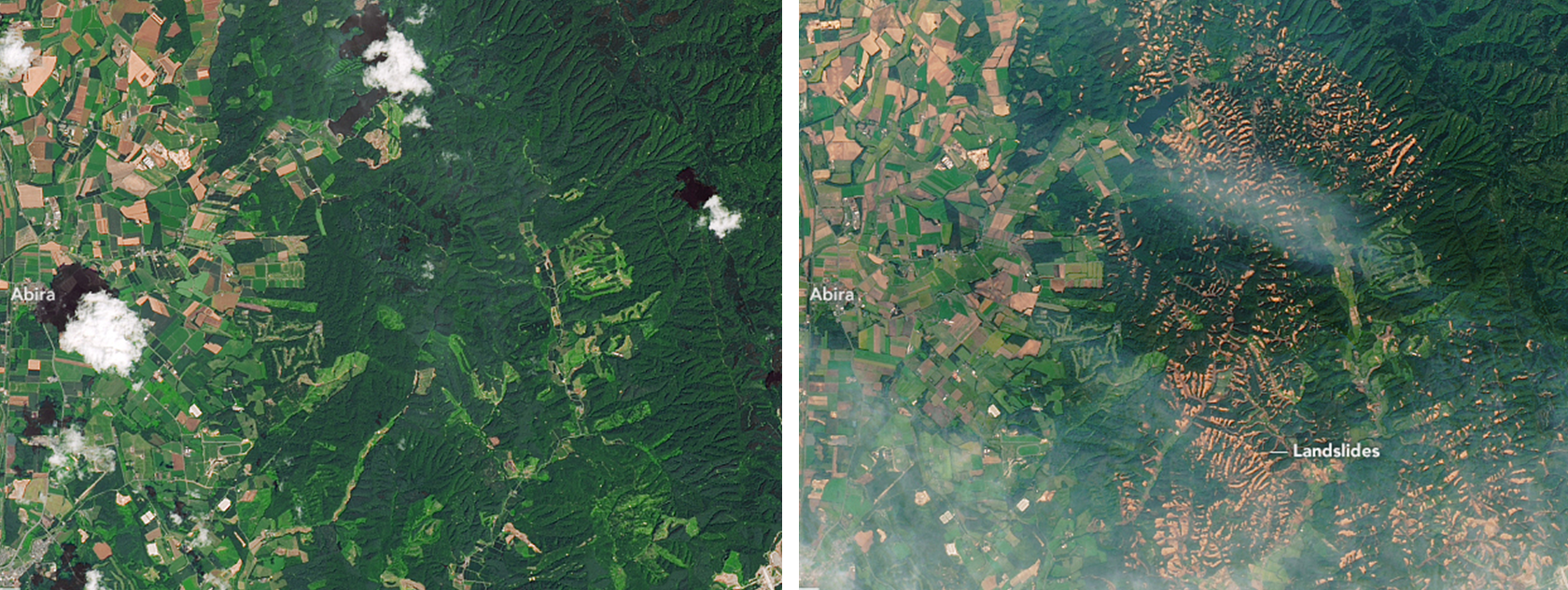
Media Attributions
- Figure 15.1.1, 15.1.2, 15.1.3, 15.1.4, 15.1.5: © Steven Earle. CC BY.
- Figure 15.1.6: © The Province. Used with permission.
- Figure 15.1.7: "Landslides in Hokkaido" by Lauren Dauphin, NASA Earth Observatory. Public domain.
It’s important to classify slope failures so that we can understand what causes them and learn how to mitigate their effects. The three criteria used to describe slope failures are:
- The type of material that failed (typically either bedrock or unconsolidated sediment)
- The mechanism of the failure (how the material moved)
- The rate at which it moved
The type of motion is the most important characteristic of a slope failure, and there are three different types of motion:
- If the material drops through the air, vertically or nearly vertically, it’s known as a fall.
- If the material moves as a mass along a sloping surface (without internal motion within the mass), it’s a slide.
- If the material has internal motion, like a fluid, it’s a flow.
Unfortunately it’s not normally that simple. Many slope failures involve two of these types of motion, some involve all three, and in many cases, it’s not easy to tell how the material moved. The types of slope failure that we’ll cover here are summarized in Table 15.1.
| [Skip Table] | |||
| Failure Type | Type of Material | Type of Motion | Rate of Motion |
|---|---|---|---|
| Rock fall | Rock fragments | Vertical or near-vertical fall (plus bouncing in many cases) | Very fast (Greater than 10s of metres per second) |
| Rock slide | A large rock body | Motion as a unit along a planar surface (translational sliding) | Typically very slow (millimetres per year to centimetres per year), but some can be faster |
| Rock avalanche | A large rock body that slides and then breaks into small fragments | Flow (at high speeds the mass of rock fragments is suspended on a cushion of air) | Very fast (Greater than tens of metres per second) |
| Creep or solifluction | Soil or other overburden; in some cases, mixed with ice | Flow (although sliding motion may also occur) | Very slow (millimetres per year to centimetres per year) |
| Slump | Thick deposits (a metre to 10s of metres) of unconsolidated sediment | Motion as a unit along a curved surface (rotational sliding) | Slow (centimetres per year to metres per year) |
| Mudflow | Loose sediment with a significant component of silt and clay | Flow (a mixture of sediment and water moves down a channel) | Moderate to fast (centimetres per second to metres per second) |
| Debris flow | Sand, gravel, and larger fragments | Flow (similar to a mudflow, but typically faster) | Fast (metres per second) |
Rock Fall
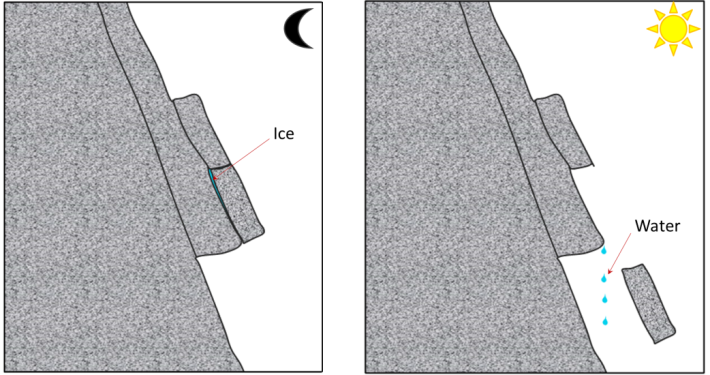
Rock fragments can break off relatively easily from steep bedrock slopes, most commonly due to frost-wedging in areas where there are many freeze-thaw cycles per year. If you’ve ever hiked along a steep mountain trail on a cool morning, you might have heard the occasional fall of rock fragments onto a talus slope. This happens because the water between cracks freezes and expands overnight, and then when that same water thaws in the morning sun, the fragments that had been pushed beyond their limit by the ice fall to the slope below (Figure 15.2.1).
A typical talus slope, near Keremeos in southern B.C., is shown in Figure 15.2.2. In December 2014, a large block of rock split away from a cliff in this same area. It broke into smaller pieces that tumbled down the slope and crashed into the road, smashing the concrete barriers and gouging out large parts of the pavement. Luckily no one was hurt.
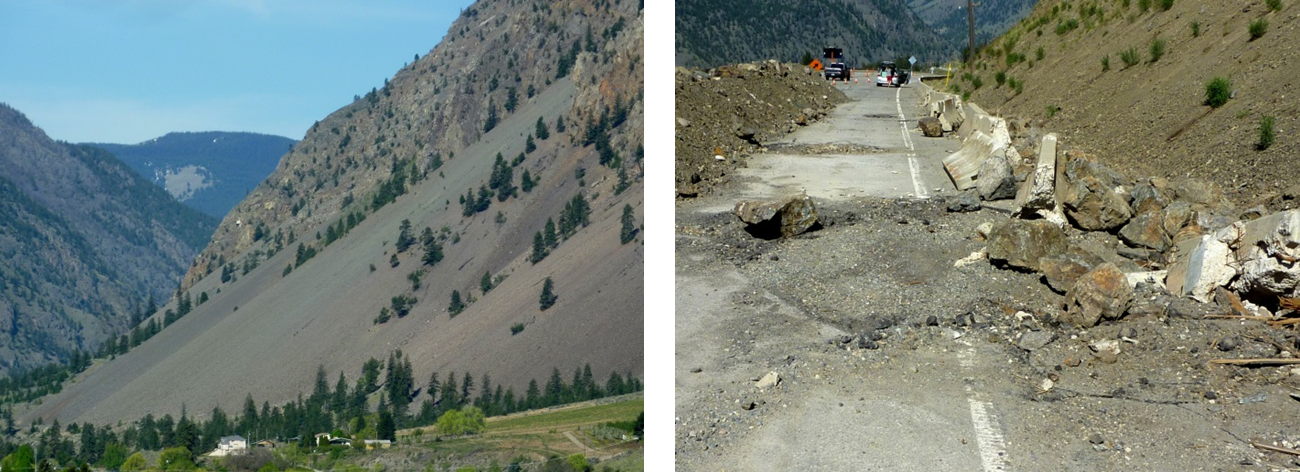
Rock Slide
A rock slide is the sliding motion of rock along a sloping surface. In most cases, the movement is parallel to a fracture, bedding, or metamorphic foliation plane, and it can range from very slow to moderately fast. The word sackung describes the very slow motion of a block of rock (millimetres per year to centimetres per year) on a slope. A good example is the Downie Slide north of Revelstoke, B.C., which is shown in Figure 15.2.3. In this case, a massive body of rock is very slowly sliding down a steep slope along a plane of weakness that is approximately parallel to the slope. The Downie Slide, which was first recognized in the 1950s, prior to the construction of the Revelstoke Dam in the late 1970s, was moving very slowly at the time (a few centimetres per year). Geological engineers were concerned that the presence of water in the reservoir (visible in Figure 15.2.3) could further weaken the plane of failure, leading to an acceleration of the motion. The result would have been a catastrophic failure into the reservoir that would have sent a wall of water over the dam and into the community of Revelstoke. During the construction of the dam they tunneled into the rock at the base of the slide and drilled hundreds of drainage holes upward into the plane of failure. This allowed water to drain out so that the pressure was reduced, which reduced the rate of movement of the sliding block. BC Hydro monitors this site continuously; the slide block is currently moving more slowly than it was prior to the construction of the dam.
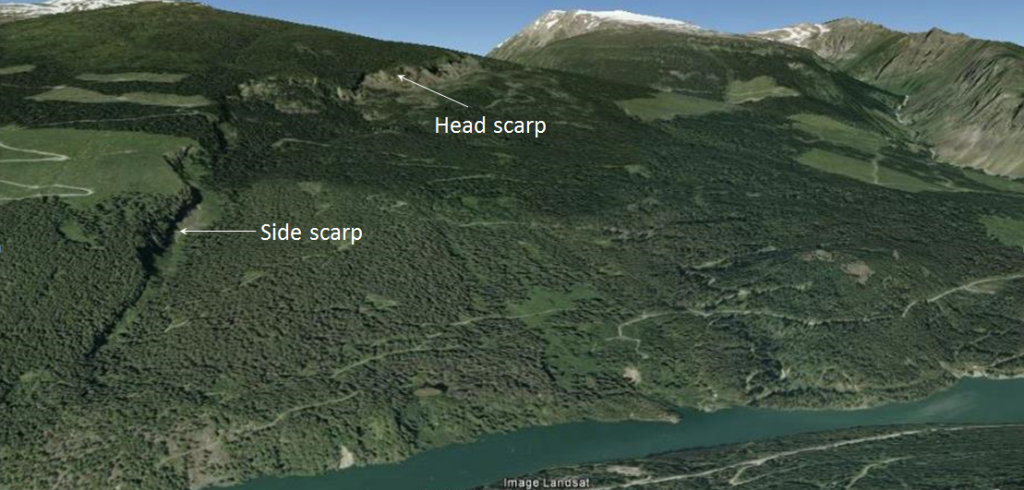
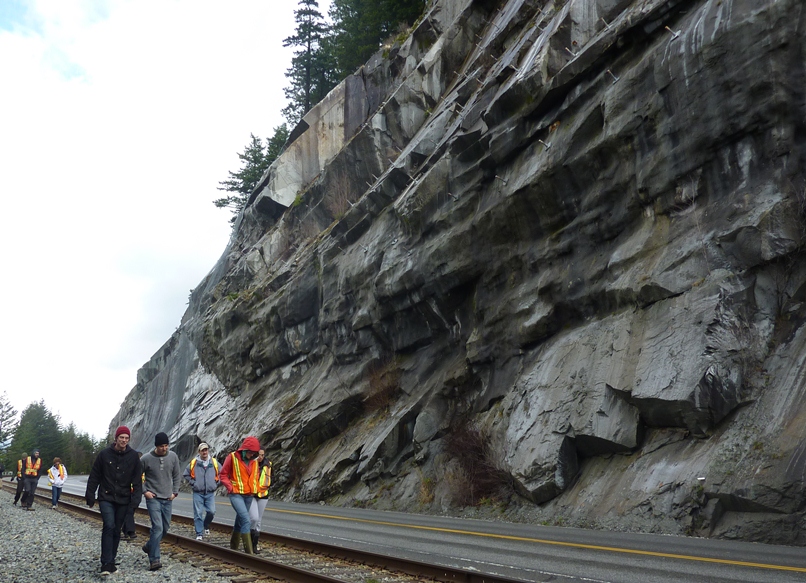
In the summer of 2008, a large block of rock slid rapidly from a steep slope above Highway 99 near Porteau Cove (between Horseshoe Bay and Squamish). The block slammed into the highway and adjacent railway and broke into many pieces. The highway was closed for several days, and the slope was subsequently stabilized with rock bolts and drainage holes. As shown in Figure 15.2.4, the rock is fractured parallel to the slope, and this almost certainly contributed to the failure. However, it is not actually known what triggered this event as the weather was dry and warm during the preceding weeks, and there was no significant earthquake in the region.
Rock Avalanche

If a rock slides and then starts moving quickly (metres per second), the rock is likely to break into many small pieces, and at that point it turns into a rock avalanche, in which the large and small fragments of rock move in a fluid manner supported by a cushion of air within and beneath the moving mass. The 1965 Hope Slide (Figure 15.0.1) was a rock avalanche, as was the famous 1903 Frank Slide in southwestern Alberta. The 2010 slide at Mount Meager (west of Lillooet) was also a rock avalanche, and rivals the Hope Slide as the largest slope failure in Canada during historical times (Figure 15.2.5).
Creep or Solifluction
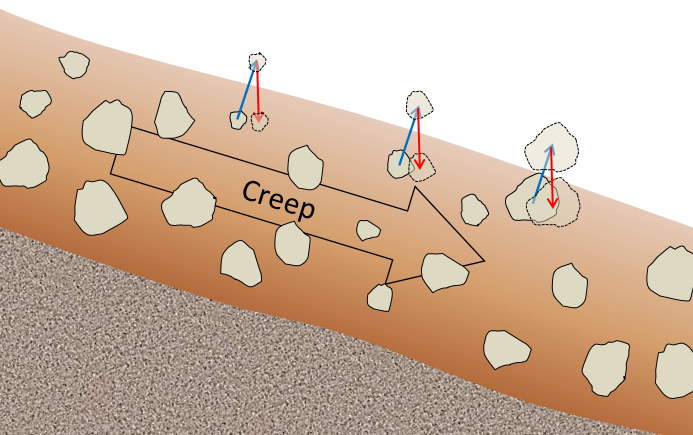
The very slow—millimetres per year to centimetres per year—movement of soil or other unconsolidated material on a slope is known as creep. Creep, which normally only affects the upper several centimetres of loose material, is typically a type of very slow flow, but in some cases, sliding may take place. Creep can be facilitated by freezing and thawing because, as shown in Figure 15.2.6, particles are lifted perpendicular to the surface by the growth of ice crystals within the soil, and then let down vertically by gravity when the ice melts. The same effect can be produced by frequent wetting and drying of the soil. In cold environments, solifluction is a more intense form of freeze-thaw-triggered creep.
Creep is most noticeable on moderate-to-steep slopes where trees, fence posts, or grave markers are consistently leaning in a downhill direction. In the case of trees, they try to correct their lean by growing upright, and this leads to a curved lower trunk known as a “pistol butt.” An example is shown on Figure 15.2.7.
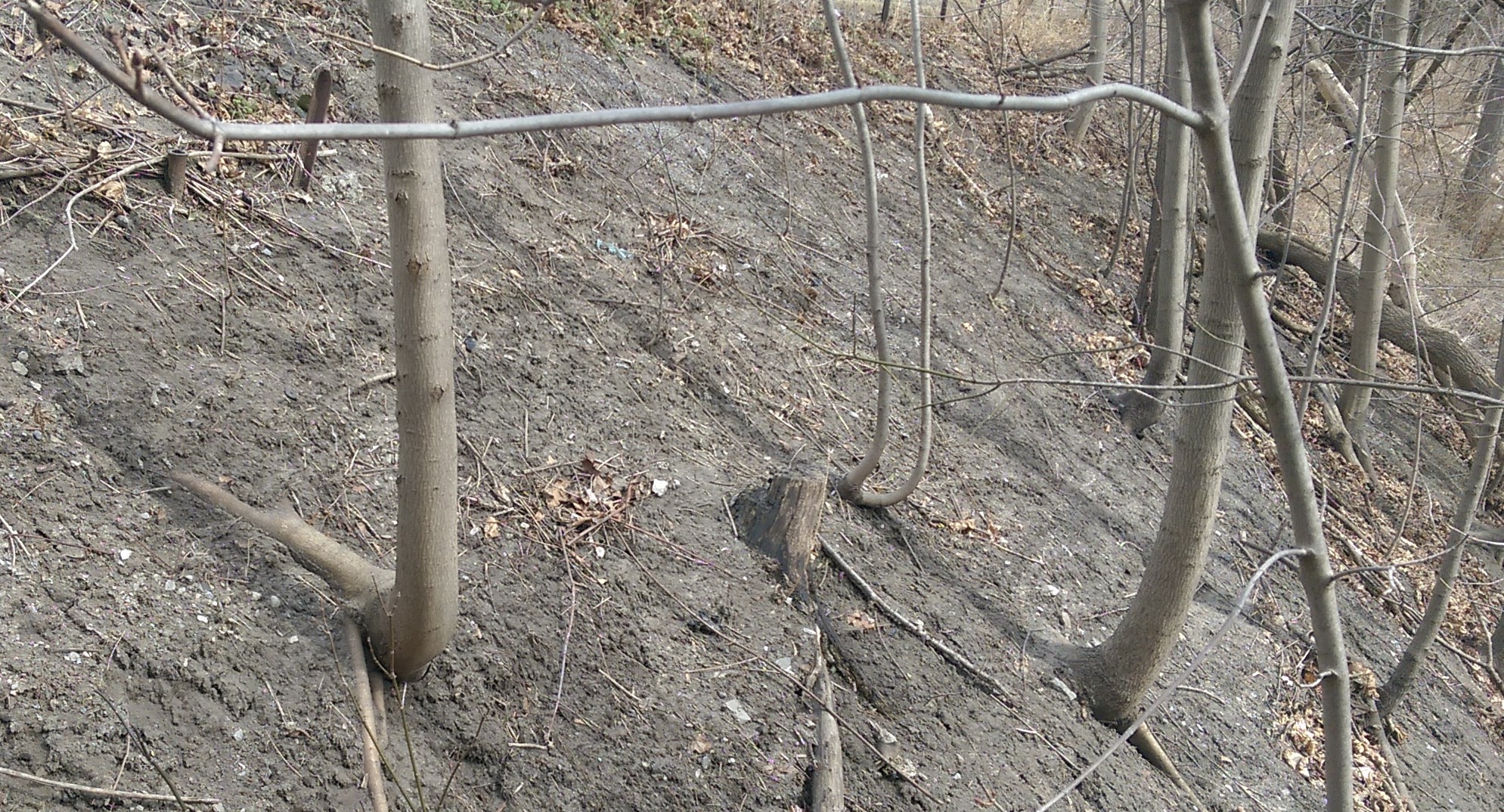
Slump

Slump is a type of slide (movement as a mass) that takes place within thick unconsolidated deposits (typically thicker than 10 metres). Slumps involve movement along one or more curved failure surfaces, with downward motion near the top and outward motion toward the bottom (Figure 15.2.8). They are typically caused by an excess of water within these materials on a steep slope.

An example of a slump in the Lethbridge area of Alberta is shown in Figure 15.2.9. This feature has likely been active for many decades, and moves a little more whenever there are heavy spring rains and significant snowmelt runoff. The toe of the slump is failing because it has been eroded by the small stream at the bottom.
Mudflows and Debris Flows
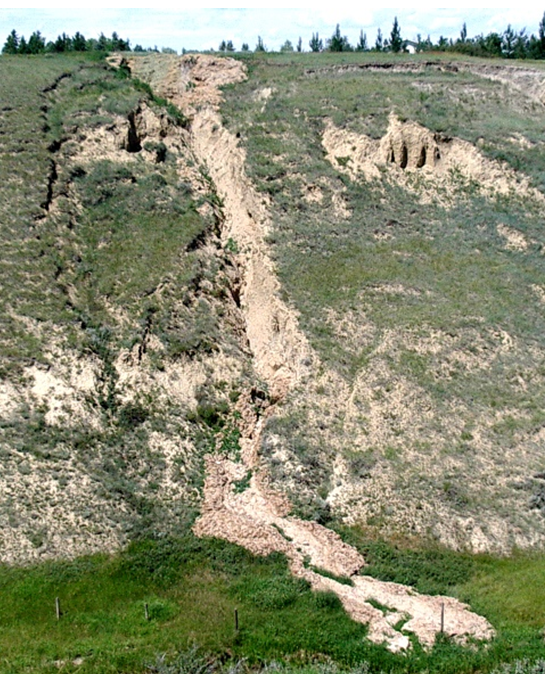
As you saw in Exercise 15.1, when a mass of sediment becomes completely saturated with water, the mass loses strength, to the extent that the grains are pushed apart, and it will flow, even on a gentle slope. This can happen during rapid spring snowmelt or heavy rains, and is also relatively common during volcanic eruptions because of the rapid melting of snow and ice. (A mudflow or debris flow on a volcano or during a volcanic eruption is a lahar.) If the material involved is primarily sand-sized or smaller, it is known as a mudflow, such as the one shown in Figure 15.2.10.
If the material involved is gravel sized or larger, it is known as a debris flow. Because it takes more gravitational energy to move larger particles, a debris flow typically forms in an area with steeper slopes and more water than does a mudflow. In many cases, a debris flow takes place within a steep stream channel, and is triggered by the collapse of bank material into the stream. This creates a temporary dam, and then a major flow of water and debris when the dam breaks. This is the situation that led to the fatal debris flow at Johnsons Landing, B.C., in 2012. A typical west-coast debris flow is shown in Figure 15.2.11. This event took place in November 2006 in response to very heavy rainfall. There was enough energy to move large boulders and to knock over large trees.

Exercise 15.2 Classifying slope failures
These four photos show some of the different types of slope failures described above. Try to identify each types and provide some criteria to support your choice.
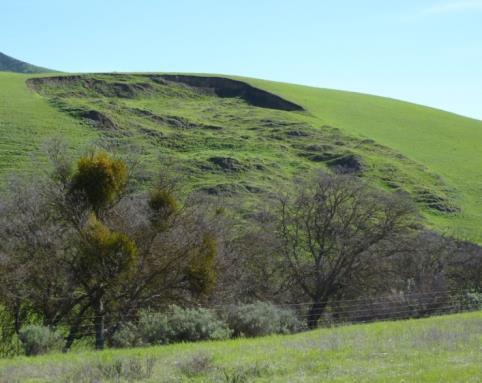
|
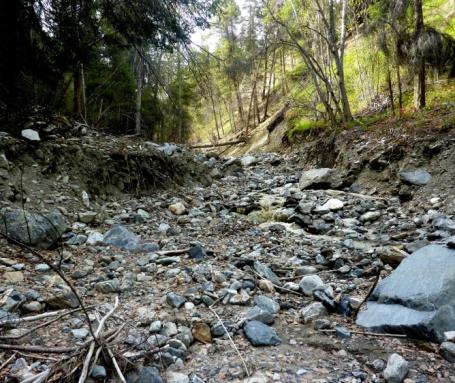 |
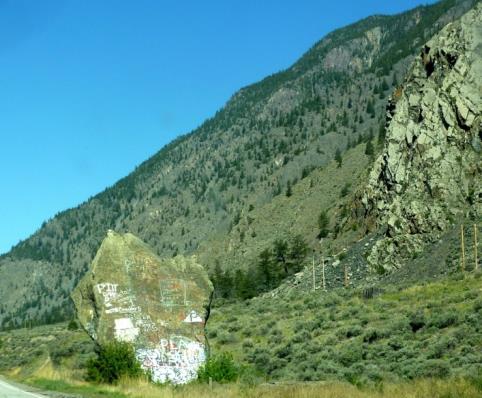 |
 |
| a: | b: |
| c: | d: |
See Appendix 3 for Exercise 15.2 answers.
Media Attributions
- Figure 15.2.1, 15.2.2: © Steven Earle. CC BY.
- Figure 15.2.3: © Google Earth. Used with permission for non-commerical purposes.
- Figure 15.2.4: © Steven Earle. CC BY.
- Figure 15.2.5: "2010 Mt. Meager rock avalanche" © Isaac Earle. CC BY.
- Figure 15.2.6, 15.2.7, 15.2.8, 15.2.9, 15.2.10, 15.2.11, 15.2.12: © Steven Earle. CC BY.
We are currently in the middle of a glacial period (although it’s less intense now than it was 20,000 years ago) but this is not the only period of glaciation in Earth’s history; there have been many in the distant past, as illustrated in Figure 16.1.1. In general, however, Earth has been warm enough to be ice-free for much more of the time than it has been cold enough to be glaciated.

The oldest known glacial period is the Huronian. Based on evidence of glacial deposits from the area around Lake Huron in Ontario and elsewhere, it is evident that the Huronian Glaciation lasted from approximately 2,400 to 2,100 Ma. Because rocks of that age are rare, we don’t know much about the duration, intensity or global extent of this glaciation.
Late in the Proterozoic, for reasons that are not fully understood, the climate cooled dramatically and Earth was seized by what appears to be its most intense glaciation. The glaciations of the Cryogenian Period (cryo is Latin for icy cold) are also known as the “Snowball Earth” glaciations, because it is hypothesized that the entire planet was frozen—even in equatorial regions—with ice up to 1 km thick on the oceans. A visitor to our planet at that time might not have held out much hope for its inhabitability, although life still survived in the oceans. There were two main glacial periods within the Cryogenian, each lasting for about 20 million years: the Sturtian at around 700 Ma and the Marinoan at 650 Ma. There is also evidence of some shorter glaciations both before and after these. The end of the Cryogenian glaciations coincides with the evolution of relatively large and complex life forms on Earth. This started during the Ediacaran Period, and then continued with the so-called explosion of life forms in the Cambrian. Some geologists think that the changing environmental conditions of the Cryogenian are what actually triggered the evolution of large and complex life.
There have been three major glaciations during the Phanerozoic (the past 540 million years), including the Andean/Saharan (recorded in rocks of South America and Africa), the Karoo (named for rocks in southern Africa), and the Cenozoic glaciations. The Karoo was the longest of the Phanerozoic glaciations, persisting for much of the time that the supercontinent Gondwana was situated over the South Pole (~360 to 260 Ma). It covered large parts of Africa, South America, Australia, and Antarctica (see Figure 10.1.3). As you might recall from Chapter 10, this widespread glaciation, across continents that are now far apart, was an important component of Alfred Wegener’s evidence for continental drift. Unlike the Cryogenian glaciations, the Andean/Saharan, Karoo, and Cenozoic glaciations only affected parts of the Earth. During Karoo times, for example, what is now North America was near the equator and remained unglaciated.
Earth was warm and essentially unglaciated throughout the Mesozoic. Although there may have been some alpine glaciation at this time, there is no longer any record of it. The dinosaurs, which dominated terrestrial habitats during the Mesozoic, did not have to endure icy conditions.
A warm climate persisted into the Cenozoic; in fact there is evidence that the Paleocene (~50 to 60 Ma) was the warmest part of the Phanerozoic since the Cambrian (Figure 16.1.2). A number of tectonic events during the Cenozoic contributed to persistent and significant planetary cooling since 50 Ma. For example, the collision of India with Asia and the formation of the Himalayan range and the Tibetan Plateau resulted in a dramatic increase in the rate of weathering and erosion. Higher than normal rates of weathering of rocks with silicate minerals, especially feldspar, consumes carbon dioxide from the atmosphere and therefore reduces the greenhouse effect, resulting in long-term cooling.
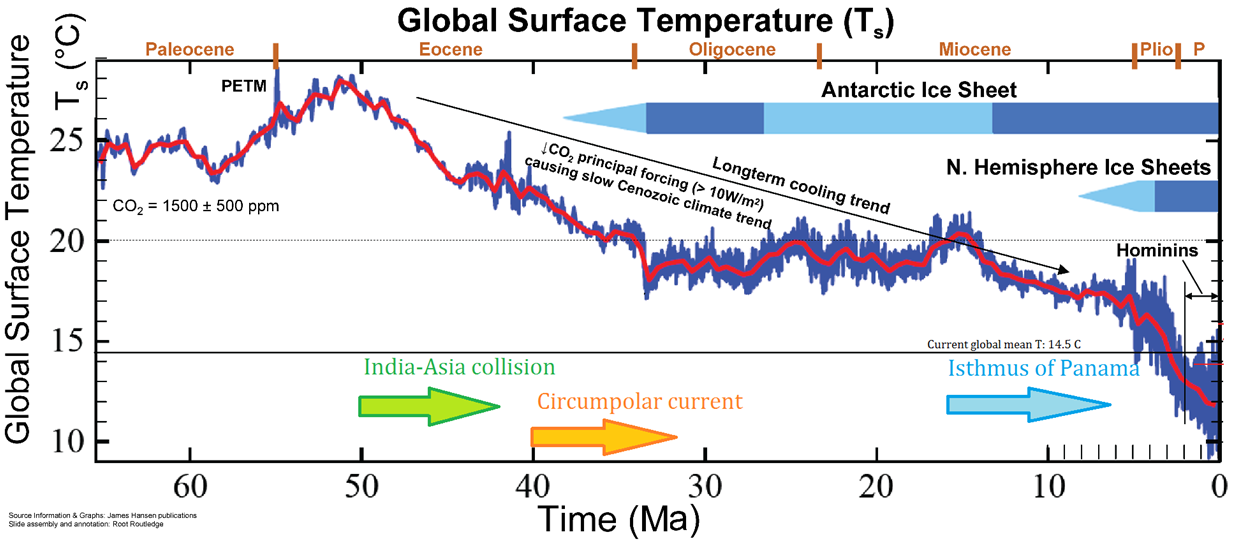

At 40 Ma, ongoing plate motion widened the narrow gap between South America and Antarctica, resulting in the opening of the Drake Passage. This allowed for the unrestricted west-to-east flow of water around Antarctica, the Antarctic Circumpolar Current (Figure 16.1.3), which effectively isolated the southern ocean from the warmer waters of the Pacific, Atlantic, and Indian Oceans. The region cooled significantly, and by 35 Ma (Oligocene) glaciers had started to form on Antarctica
Global temperatures remained relatively steady during the Oligocene and early Miocene, and the Antarctic glaciation waned during that time. At around 15 Ma, subduction-related volcanism between central and South America created the connection between North and South America, preventing water from flowing between the Pacific and Atlantic Oceans. This further restricted the transfer of heat from the tropics to the poles, leading to a rejuvenation of the Antarctic glaciation. The expansion of that ice sheet increased Earth’s reflectivity enough to promote a positive feedback loop of further cooling: more reflective glacial ice, more cooling, more ice, etc. By the Pliocene (~5 Ma) ice sheets had started to grow in North America and northern Europe (Figure 16.1.4). The most intense part of the current glaciation — and the coldest climate — has been during the past million years (the last one-third of the Pleistocene), but if we count Antarctic glaciation, it really extends from the Oligocene to the Holocene, and will likely continue into the future.
The Pleistocene has been characterized by significant temperature variations (through a range of almost 10°C) on time scales of 40,000 to 100,000 years, and corresponding expansion and contraction of ice sheets. These variations are attributed to subtle changes in Earth’s orbital parameters (Milankovitch cycles), which are explained in more detail in Chapter 21. Over the past million years, the glaciation cycles have been approximately 100,000 years; this variability is visible in Figure 16.1.4.
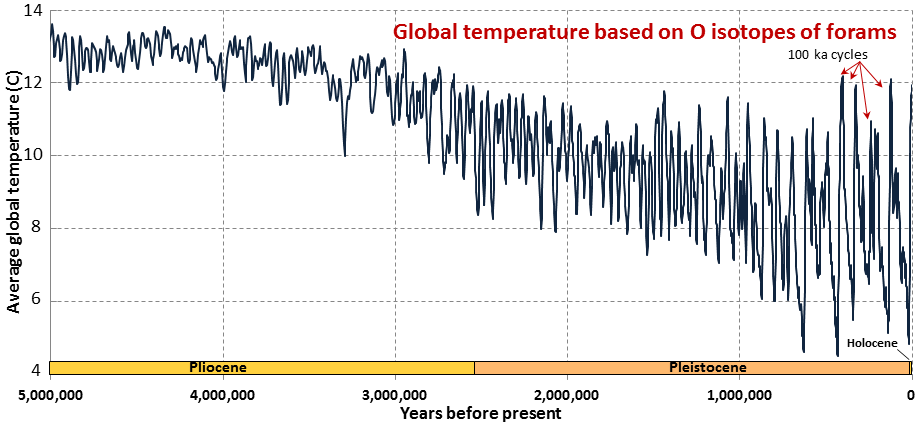
Exercise 16.1 Pleistocene glacials and interglacials
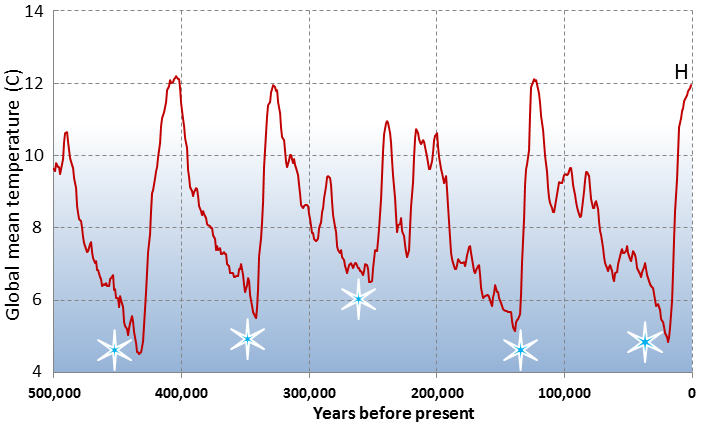
This diagram (Figure 16.1.5) shows the past 500,000 years of global temperature variations based on the same data used for Figure 16.1.4. The last five glacial periods are marked with snowflakes. The most recent one, which peaked at around 20 ka, is known as the Wisconsin Glaciation. Describe the nature of temperature change that followed each of these glacial periods.
The current interglacial (Holocene) is marked with an H. Point out the previous five interglacial periods.
See Appendix 3 for Exercise 16.1 answers.
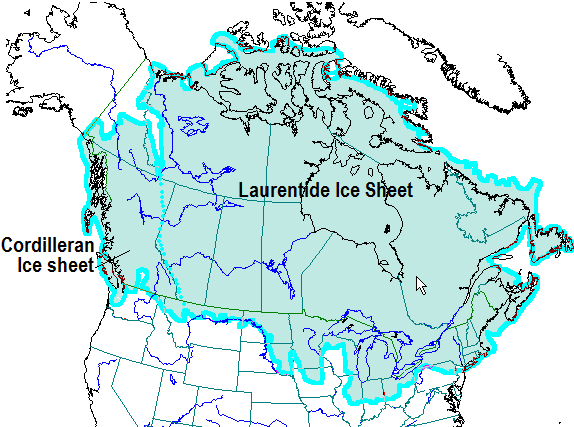
At the height of the last glaciation (Wisconsin Glaciation), massive ice sheets covered almost all of Canada and much of the northern United States (Figure 16.1.6). (In fact glacial ice extended well south of Wisconsin, into Illinois, Indiana and Ohio.) The massive Laurentide Ice Sheet covered most of eastern Canada (and adjacent USA), as far west as the Rockies, and the smaller Cordilleran Ice Sheet covered most of the western region. At various other glacial peaks during the Pleistocene and Pliocene, the ice extent was similar to this, and in some cases, even more extensive. The combined Laurentide and Cordilleran Ice Sheets were comparable in volume of ice to the current Antarctic Ice Sheet.
Media Attributions
- Figure 16.1.1, 16.1.3, 16.1.5: © Steven Earle. CC BY.
- Figure 16.1.2: © Root Routledge. Adapted by Steven Earle. Approved for non-commercial use.
- Figure 16.1.4: © Steven Earle. CC BY. Based on data by Lisiecki and Raymo, 2005.
- Figure 16.1.6: © Steven Earle. CC BY. Based on a NOAA Map.
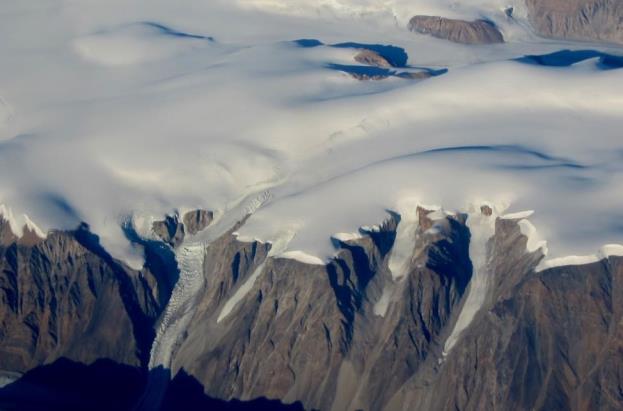
There are two main types of glaciers. Continental glaciers cover vast areas of land in extreme polar regions, including Antarctica and Greenland (Figure 16.2.1). Alpine glaciers (a.k.a. valley glaciers) originate on mountains, mostly in temperate and polar regions (Figure 16.0.1), but even in tropical regions if the mountains are high enough.
Earth’s two great continental glaciers, on Antarctica and Greenland, comprise about 99% of all of the world’s glacial ice, and approximately 68% of all of Earth’s fresh water. As is evident from Figure 16.2.2, the Antarctic Ice Sheet is vastly bigger than the Greenland Ice Sheet; it contains about 17 times as much ice. If the entire Antarctic Ice Sheet were to melt, sea level would rise by about 80 m and most of Earth’s major cities would be completely submerged.


Continental glaciers do not flow “downhill” because the large areas that they cover are generally flat. Instead, ice flows from the region where it is thickest toward the edges where it is thinner, as shown in Figure 16.2.3. This means that in the central thickest parts, the ice flows almost vertically down toward the base, while in the peripheral parts, it flows out toward the margins. In continental glaciers like Antarctica and Greenland, the thickest parts (4,000 m and 3,000 m respectively) are the areas where the rate of snowfall and therefore the rate of ice accumulation are highest.

The flow of alpine glaciers is primarily controlled by the slope of the land beneath the ice (Figure 16.2.4). In the zone of accumulation, the rate of snowfall is greater than the rate of melting. In other words, not all of the snow that falls each winter melts during the following summer, and the ice surface is always covered with snow. In the zone of ablation, more ice melts than accumulates as snow. The equilibrium line marks the boundary between the zones of accumulation (above) and ablation (below).
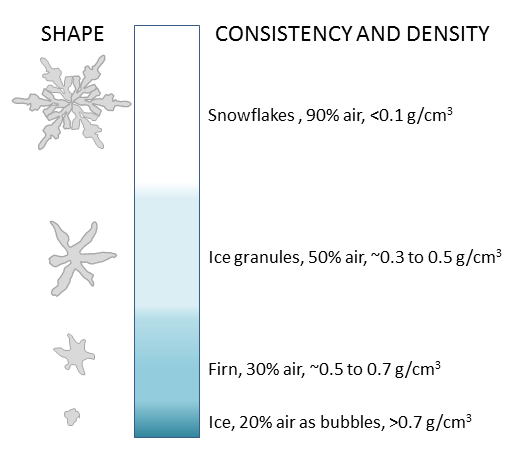
Above the equilibrium line of a glacier, not all of the winter snow melts in the following summer, so snow gradually accumulates. The snow layer from each year is covered and compacted by subsequent snow, and it is gradually compressed and turned into firn within which the snowflakes lose their delicate shapes and become granules. With more compression, the granules are pushed together and air is squeezed out. Eventually the granules are “welded” together to create glacial ice (Figure 16.2.5). Downward percolation of water from melting taking place at the surface contributes to the process of ice formation.
The equilibrium line of a glacier near Whistler, B.C., is shown in Figure 16.2.6. Below that line, in the zone of ablation, bare ice is exposed because last winter’s snow has all melted; above that line, the ice is still mostly covered with snow from last winter. The position of the equilibrium line changes from year to year as a function of the balance between snow accumulation in the winter and snowmelt during the summer. More winter snow and less summer melting obviously favours the advance of the equilibrium line (and of the glacier’s leading edge), but of these two variables, it is the summer melt that matters most to a glacier’s budget. Cool summers promote glacial advance and warm summers promote glacial retreat.
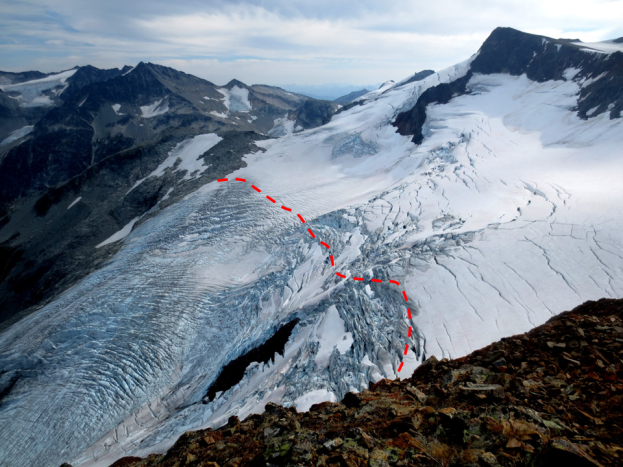
Glaciers move because the surface of the ice is sloped. This generates a stress on the ice, which is proportional to the slope and to the depth below the surface. As shown in Figure 16.2.6, the stresses are quite small near the ice surface but much larger at depth, and also greater in areas where the ice surface is relatively steep. Ice will deform, meaning that it will behave in a plastic manner, at stress levels of around 100 kilopascals; therefore, in the upper 50 m to 100 m of the ice (above the dashed red line), flow is not plastic (the ice is rigid), while below that depth, ice is plastic and will flow.
When the lower ice of a glacier flows, it moves the upper ice along with it, so although it might seem from the stress patterns (red numbers and red arrows) shown in Figure 16.2.7 that the lower part moves the most, in fact while the lower part deforms (and flows) and the upper part doesn’t deform at all, the upper part moves the fastest because it is pushed along by the lower ice.

The plastic lower ice of a glacier can flow like a very viscous fluid, and can therefore flow over irregularities in the base of the ice and around corners. However, the upper rigid ice cannot flow in this way, and because it is being carried along by the lower ice, it tends to crack where the lower ice has to flex. This leads to the development of crevasses in areas where the rate of flow of the plastic ice is changing. In the area shown in Figure 16.2.8, for example, the glacier is speeding up over the steep terrain, and the rigid surface ice has to crack to account for the change in velocity.
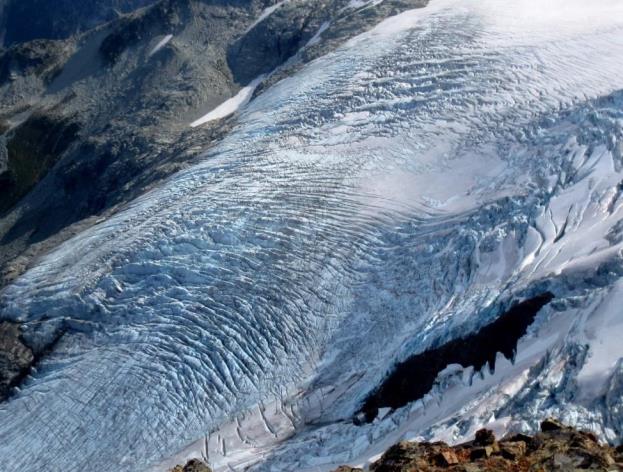
The plastic lower ice of a glacier can flow like a very viscous fluid, and can therefore flow over irregularities in the base of the ice and around corners. However, the upper rigid ice cannot flow in this way, and because it is being carried along by the lower ice, it tends to crack where the lower ice has to flex. This leads to the development of crevasses in areas where the rate of flow of the plastic ice is changing. In the area shown in Figure 16.2.8, for example, the glacier is speeding up over the steep terrain, and the rigid surface ice has to crack to account for the change in velocity
The base of a glacier can be cold (below the freezing point of water) or warm (above the freezing point). If it is warm, there will likely be a film of water between the ice and the material underneath, and the ice will be able to slide over that surface. This is known as basal sliding (Figure 16.2.9, left). If the base is cold, the ice will be frozen to the material underneath and it will be stuck—unable to slide along its base. In this case, all of the movement of the ice will be by internal flow.

One of the factors that affects the temperature at the base of a glacier is the thickness of the ice. Ice is a good insulator. The slow transfer of heat from Earth’s interior provides enough heat to warm up the base if the ice is thick, but not enough if it is thin and that heat can escape. It is typical for the leading edge of an alpine glacier to be relatively thin (see Figure 16.2.7), so it is common for that part to be frozen to its base while the rest of the glacier is still sliding. This is illustrated in Figure 16.2.10 for the Athabasca Glacier. Because the leading edge of the glacier is stuck to its frozen base, while the rest continues to slide, the ice coming from behind has pushed (or thrust) itself over top of the part that is stuck fast.


Just as the base of a glacier moves more slowly than the surface, the edges, which are more affected by friction along the sides, move more slowly than the middle. If we were to place a series of markers across an alpine glacier and come back a year later, we would see that the ones in the middle had moved farther forward than the ones near the edges (Figure 16.2.11).
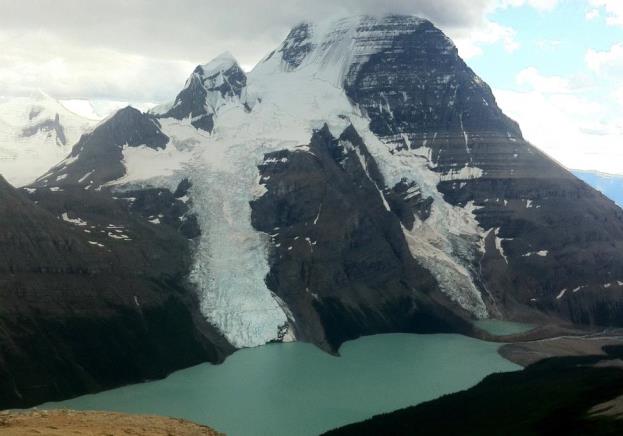
Glacial ice always moves downhill, in response to gravity, but the front edge of a glacier is always either melting or calving into water (shedding icebergs). If the rate of forward motion of the glacier is faster than the rate of ablation (melting), the leading edge of the glacier advances (moves forward). If the rate of forward motion is about the same as the rate of ablation, the leading edge remains stationary, and if the rate of forward motion is slower than the rate of ablation, the leading edge retreats (moves backward).
Calving of icebergs is an important process for glaciers that terminate in lakes or the ocean. An example of such a glacier is the Berg Glacier on Mt. Robson (Figure 16.2.12), which sheds small icebergs into Berg Lake. The Berg Glacier also loses mass by melting, especially at lower elevations.
Exercise 16.2 Ice advance and retreat
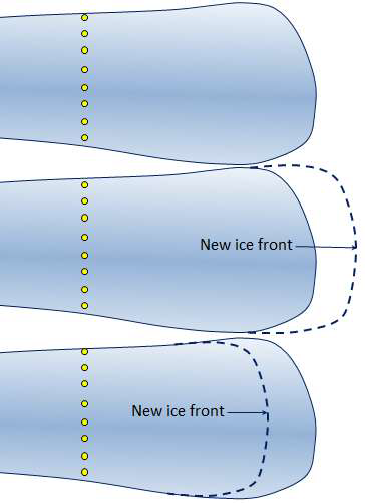
These diagrams represent a glacier with markers placed on its surface to determine the rate of ice motion over a one-year period. The ice is flowing from left to right.
- In the middle diagram, the leading edge of the glacier has advanced. Draw in the current position of the markers.
- In the lower diagram, the leading edge of the glacier has retreated. Draw in the current position of the markers.
See Appendix 3 for Exercise 16.2 answers.
Image Descriptions
Figure 16.2.2 image description: An east to west cross section of the ice on Antarctica is over 4000 km long and up to 4 km high in some places. An east to west cross section of the ice on Greenland is less than 1000 km long and up to 3 km high. [Return to Figure 16.2.2]
Media Attributions
- Figures 16.2.1, 16.2.2, 16.2.3, 16.2.4, 16.2.5, 16.2.7: © Steven Earle. CC BY.
- Figure 16.2.6: "Overlord Glacier" by Isaac Earle. Adapted by Steven Earle. CC BY.
- Figure 16.2.8: "Crevasses at Overlord Glacier" by Isaac Earle. CC BY.
- Figures 16.2.9, 16.2.10, 16.2.11, 16.2.12, 16.2.13: © Steven Earle. CC BY.
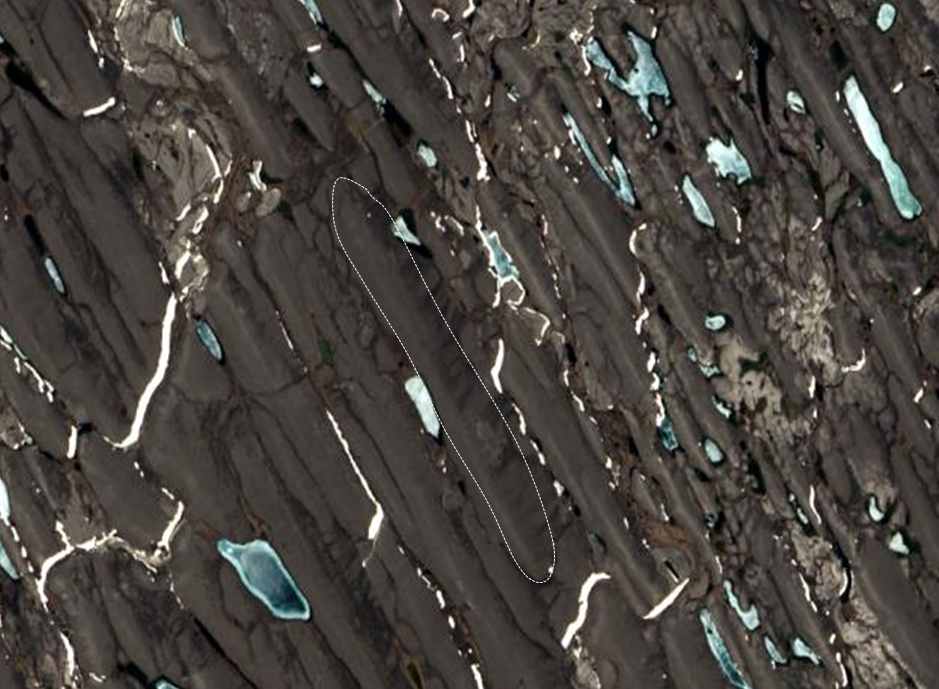
Glaciers are effective agents of erosion, especially in situations where the ice is not frozen to its base and can therefore slide over the bedrock or other sediment. In fact the ice itself is not particularly effective at erosion because it is relatively soft (Mohs hardness 1.5 at 0°C); instead, it is the rock fragments embedded in the ice and pushed down onto the underlying surfaces that do most of the erosion. A useful analogy would be to compare the effect of a piece of paper being rubbed against a wooden surface, as opposed to a piece of sandpaper that has embedded angular fragments of garnet.
The results of glacial erosion are different in areas with continental glaciation versus alpine glaciation. Continental glaciation tends to produce relatively flat bedrock surfaces, especially where the rock beneath is uniform in strength. In areas where there are differences in the strength of rocks, a glacier obviously tends to erode the softer and weaker rock more effectively than the harder and stronger rock. Much of central and eastern Canada, which was completely covered by the huge Laurentide Ice Sheet at various times during the Pleistocene, has been eroded to a relatively flat surface. In many cases the existing relief is due the presence of glacial deposits—such as drumlins, eskers, and moraines (all discussed below)—rather than to differential erosion (Figure 16.3.1).
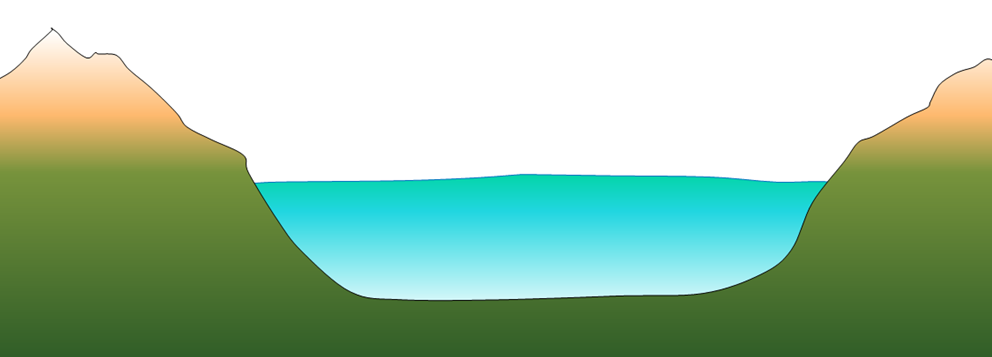
Alpine glaciers produce very different topography than continental glaciers, and much of the topographic variability of western Canada can be attributed to glacial erosion. In general, glaciers are much wider than rivers of similar length, and since they tend to erode more at their bases than their sides, they produce wide valleys with relatively flat bottoms and steep sides—known as U-shaped valleys (Figure 16.3.2). Howe Sound, north of Vancouver, was occupied by a large glacier that originated in the Squamish, Whistler, and Pemberton areas, and then joined the much larger glacier in the Strait of Georgia. Howe Sound and most of its tributary valleys have pronounced U-shaped profiles (Figure 16.3.3).
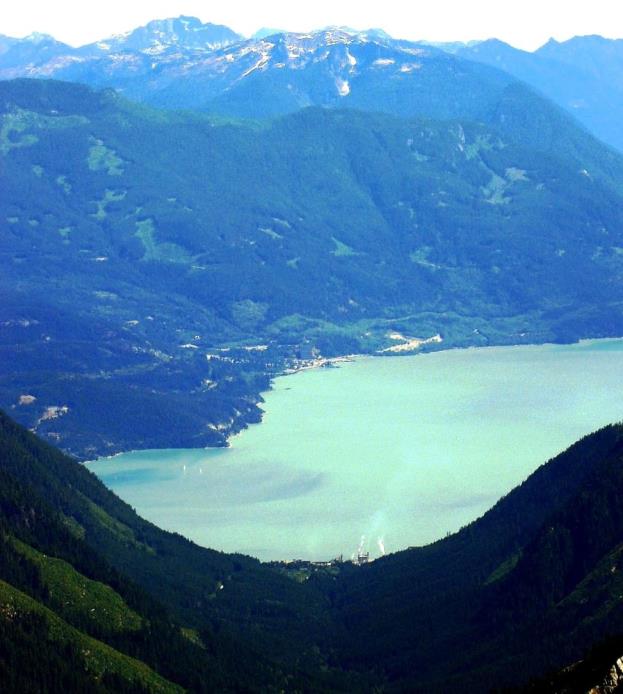
U-shaped valleys and their tributaries provide the basis for a wide range of alpine glacial topographic features, examples of which are visible on the International Space Station view of the Swiss Alps shown in Figure 16.3.4. This area was much more intensely glaciated during the past glacial maximum. At that time, the large U-shaped valley in the lower right was occupied by glacial ice, and all of the other glaciers shown here were longer and much thicker than they are now. But even at the peak of the Pleistocene Glaciation, some of the higher peaks and ridges would have been exposed and not directly affected by glacial erosion. A peak that extends above the surrounding glacier is called a nunatuk. In these areas, and in the areas above the glaciers today, most of the erosion is related to freeze-thaw effects.
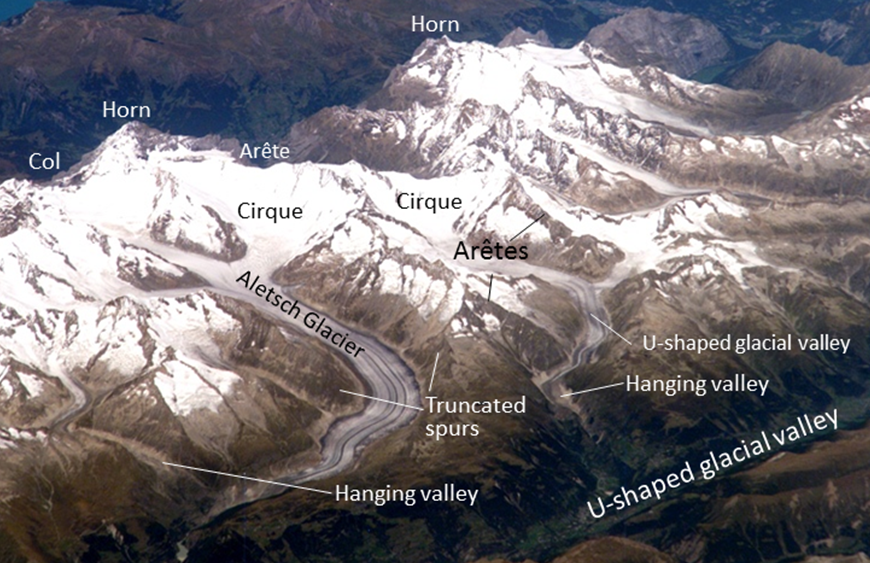
Figure 16.3.4 is a Space Station view of a glaciated terrain in the Swiss Alps. Some of the important features visible are arêtes: sharp ridges between U-shaped glacial valleys; cols: low points along arêtes that constitute passes between glacial valleys; horns: steep peaks that have been glacially and freeze-thaw eroded on three or more sides; cirques: bowl-shaped basins that form at the head of a glacial valley; hanging valleys: U-shaped valleys of tributary glaciers that hang above the main valley because the larger main-valley glacier eroded more deeply into the terrain; and truncated spurs (a.k.a. “spurs”): the ends of arêtes that have been eroded into steep triangle-shaped cliffs by the glacier in the corresponding main valley.
Some of these alpine-glaciation erosional features are also shown in Figure 16.3.5 in diagram form.
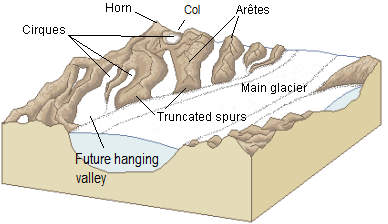
Exercise 16.3 Identify alpine glacial erosion features
This is a photo of Mt. Assiniboine in the B.C. Rockies. What are the features at locations a through e? Look for one of each of the following: a horn, an arête, a truncated spur, a cirque, and a col. Try to identify some of the numerous other arêtes in this view, as well as another horn.
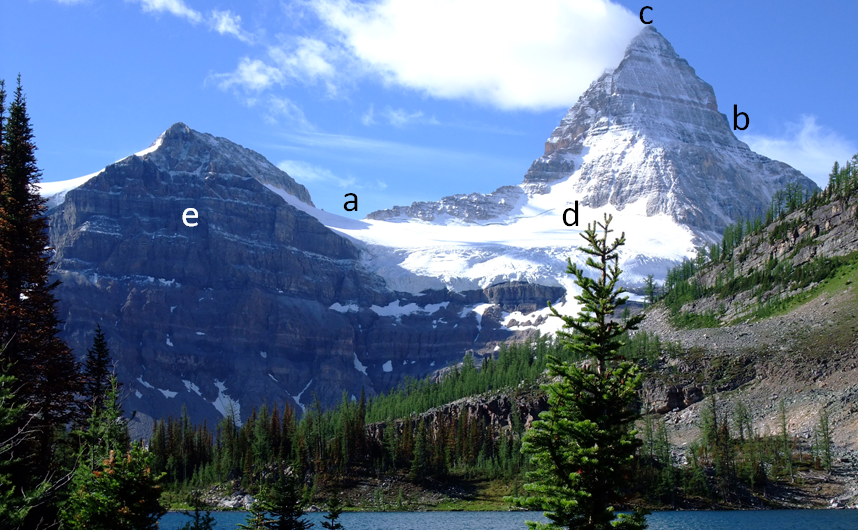
See Appendix 3 for Exercise 16.3 answers.
A number of other glacial erosion features exist at smaller scales. For example, a drumlin is an elongated feature that is streamlined at the down-ice end. The one shown in Figure 16.3.7 is larger than most, and is made up almost entirely of rock. Drumlins made up of glacial sediments are very common in some areas of continental glaciation (Figure 16.3.1).
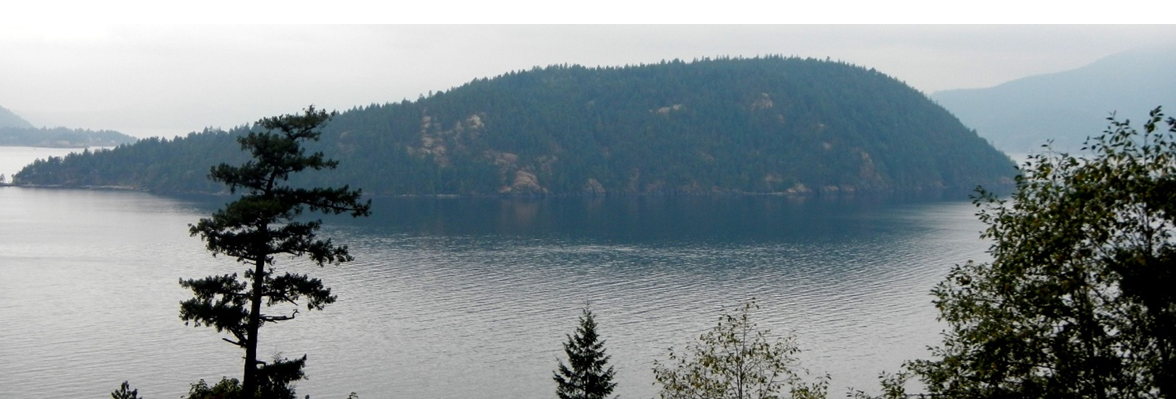
A roche moutonée is another type of elongated erosional feature that has a steep and sometimes jagged down-ice end (Figure 16.3.8, left). On a smaller scale still, glacial grooves (tens of centimetres to metres wide) and glacial striation (millimetres to centimetres wide) are created by fragments of rock embedded in the ice at the base of a glacier (Figure 16.3.8, left and right). Glacial striae are very common on rock surfaces eroded by both alpine and continental glaciers.
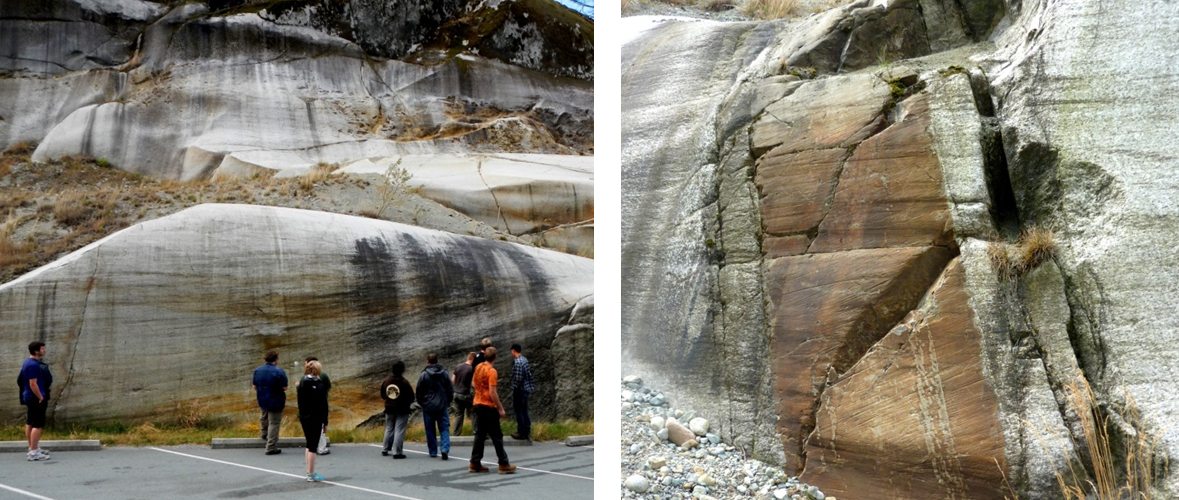
Glacial lakes

Lakes are common features in glacial environments. A lake that is confined to a glacial cirque is known as a tarn (Figure 16.3.9). Tarns are common in areas of alpine glaciation because the ice that forms a cirque typically carves out a depression in bedrock that then fills with water. In some cases, a series of such basins will form, and the resulting lakes are called rock basin lakes or paternoster lakes.
A lake that occupies a glacial valley, but is not confined to a cirque, is known as a finger lake. In some cases, a finger lake is confined by a dam formed by an end moraine, in which case it may be called a moraine lake (Figure 16.3.10).
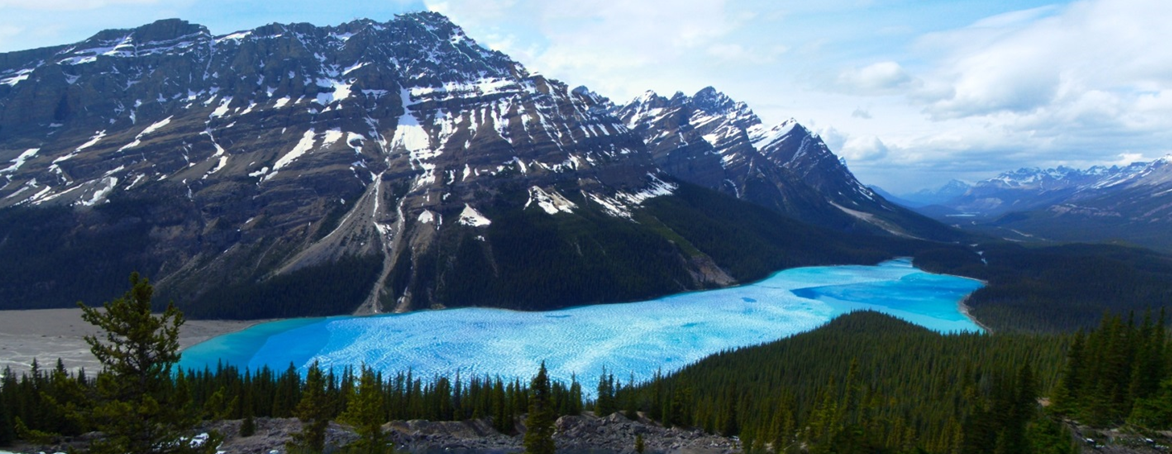
In areas of continental glaciation, the crust is depressed by the weight of glacial ice that is up to 4,000 m thick. Basins are formed along the edges of continental glaciers (except for those that cover entire continents like Antarctica and Greenland), and these basins fill with glacial meltwater. Many such lakes, some of them huge, existed at various times along the southern edge of the Laurentide Ice Sheet. One example is Glacial Lake Missoula, which formed within Idaho and Montana in northwestern United States. During the latter part of the last glaciation (30 ka to 15 ka), the ice holding back Lake Missoula retreated enough to allow some of the lake water to start flowing out, which escalated into a massive and rapid outflow (over days to weeks) during which much of the volume of the lake drained along the valley of the Columbia River to the Pacific Ocean. It is estimated that this type of flooding happened at least 25 times over that period, and in many cases, the rate of outflow was equivalent to the discharge of all of Earth’s current rivers combined. The record of these massive floods is preserved in the Channelled Scablands of Idaho, Washington, and Oregon (Figure 16.3.11).
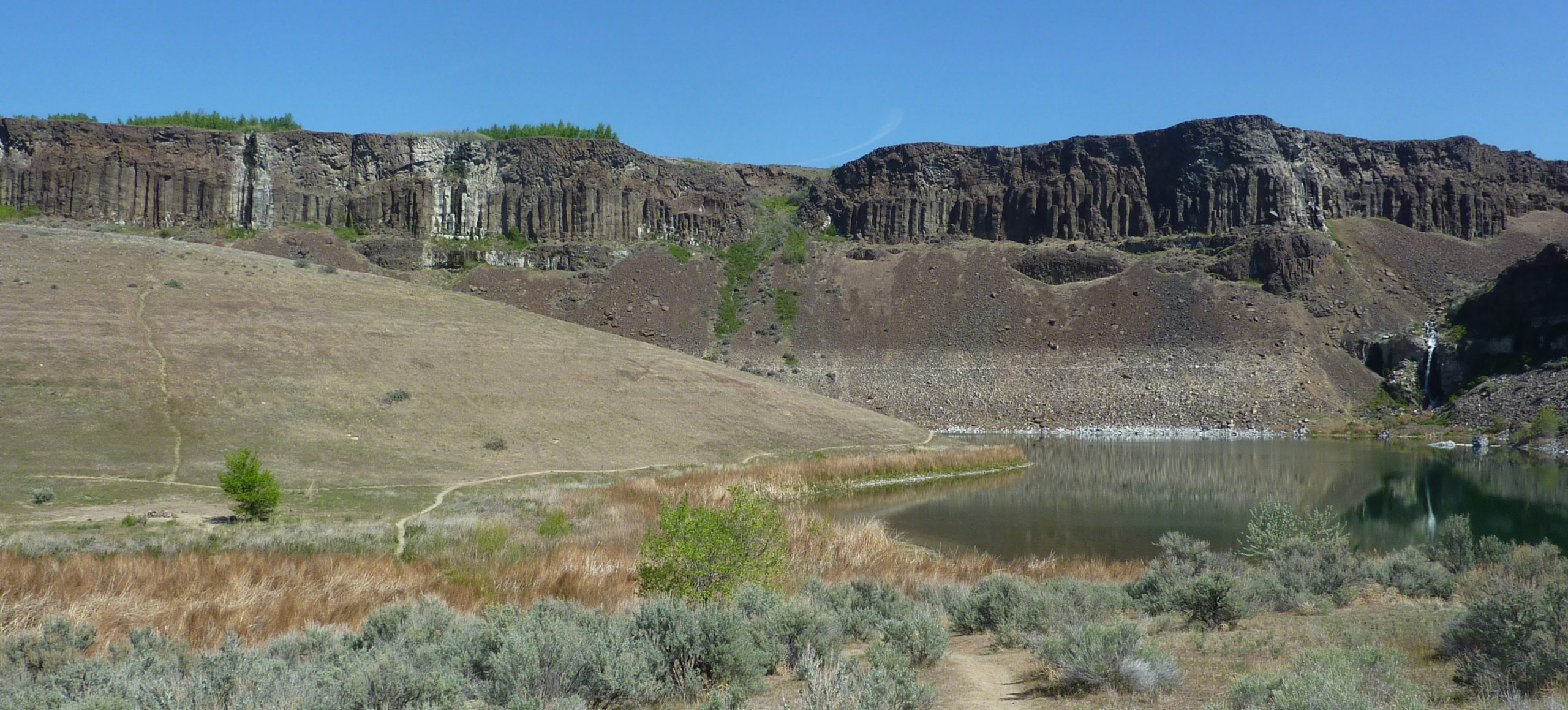
Another type of glacial lake is a kettle lake. These are discussed in section 16.4 in the context of glacial deposits.
Image Descriptions
Figure 16.3.6 image description:
- A valley between two peaks.
- A steep edge of a mountain.
- A mountain peak.
- An ice field in between two mountains.
- A flat, rocky side of a mountain.
Media Attributions
- Figure 16.3.1: © Steven Earle. CC BY.
- Figure 16.3.2: "Drumlin Field in Northern Canada" by NASA Earth Observatory. Public domain.
- Figure 16.3.3: "Woodf1a" © Keefer4. CC BY-SA.
- Figure 16.3.4: "Bernese Alps, Switzerland" by NASA Earth Observatory. Adapted by Steven Earle. Public domain.
- Figure 16.3.5: "Glacial landscape LMB" by Luis María Benítez. Public domain.
- Figure 16.3.6: "Mount Assiniboine Sunbursst Lake" © Kurt Stegmüller. Adapted by Steven Earle. CC BY.
- Figures 16.3.7, 16.3.8: © Steven Earle. CC BY.
- Figure 16.3.9: "Trappers Peak and lower Thorton Lake" © X-Weinzar. CC BY.
- Figure 16.3.10: "Peyto Lake Panorama 2006" © chensiyuan. CC BY-SA.
- Figure 16.3.11: © Steven Earle. CC BY.
